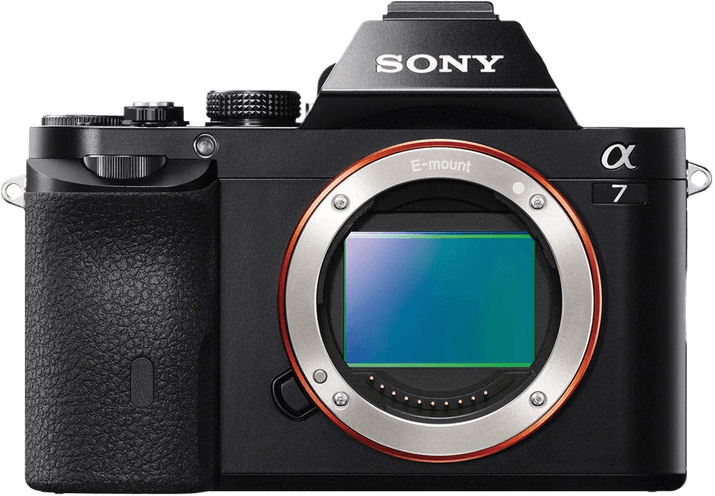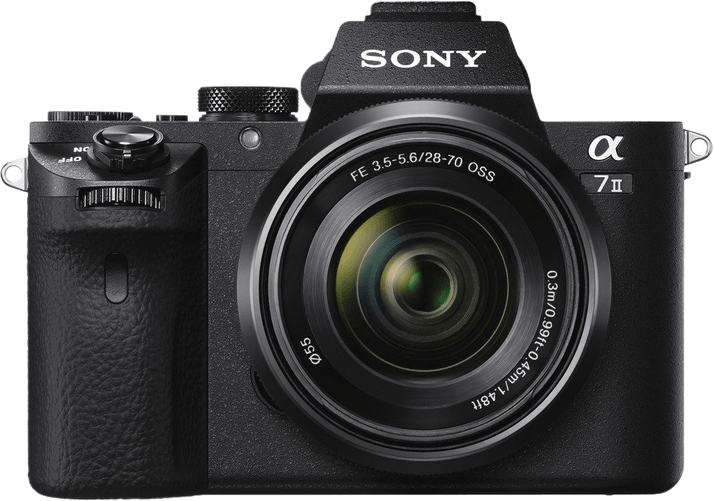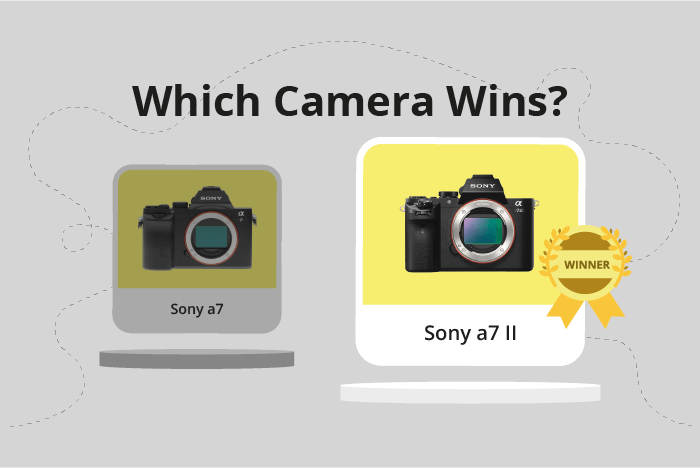Sony a7 vs a7 II Comparison
Sony a7

Sony a7 II

The Sony a7 II emerges as the winner, with a score of 69 out of 100, compared to the Sony a7’s score of 63. Both cameras are mirrorless and were released just a year apart, with the a7 II being the newer model. They share similar dimensions, but the a7 II is slightly heavier at 599g, while the a7 weighs 474g.
The a7 II has the advantage of being a more advanced camera with a lower launch price of $1600, as opposed to the a7’s $1700. However, the Sony a7 is a lighter option, making it more convenient for photographers on the go.
Taking into account the scores, prices, and weight differences, the Sony a7 II is a superior choice for those seeking better performance and value, while the Sony a7 may be more suitable for those prioritizing portability.
Sony a7 vs a7 II Overview and Optics
The Sony a7 II outperforms the Sony a7 in optics with a score of 78/100, compared to the a7’s score of 70/100. Both cameras share several common specifications, including 24 and 24.2 megapixels, 5 shooting speed, CMOS sensor type, Bionz X processor, 90 DXOMARK score for the sensor, full-frame sensor size, and Sony E lens mount.
The winning camera, the Sony a7 II, has one significant advantage: image stabilization. This feature reduces the impact of camera shake, resulting in sharper images, especially in low-light situations or when using longer lenses. The inclusion of image stabilization makes the a7 II a more versatile camera, allowing photographers to capture a wider range of images with greater clarity and detail.
The Sony a7, while scoring lower, still offers solid optics performance. In terms of megapixels, shooting speed, sensor type, processor, DXOMARK score, sensor size, and lens mount, the a7 matches the a7 II. However, it lacks image stabilization, which is the primary reason for its lower score in comparison to the a7 II.
Given the similarities in specifications between the two cameras, the choice between the Sony a7 and the Sony a7 II ultimately depends on the user’s specific needs and preferences. If image stabilization is a crucial requirement, the Sony a7 II is the better option. However, if this feature is not a priority, the Sony a7 remains a reliable and capable camera, particularly for photographers who may already have a collection of Sony E-mount lenses.
Sony a7 vs a7 II Video Performance
The Sony a7 and Sony a7 II both have a video score of 56/100, indicating no winner in this specific category. These cameras share several video specifications, making them quite similar in their video capabilities. Both cameras have a maximum video resolution of Full HD and video dimensions of 1920 x 1080. Additionally, they both offer a maximum video frame rate of 60fps. Neither camera has built-in time-lapse functionality.
Despite their identical video scores, there may be some differences between the Sony a7 and Sony a7 II that could influence a user’s preference. However, based on the provided specifications, no such differences are apparent. Consequently, both cameras seem to offer comparable video performance, and neither is better than the other in this regard.
It is essential to consider other factors such as the user’s specific requirements, preferences, and budget when choosing between these two cameras. Since their video capabilities are virtually identical, other aspects such as image quality, autofocus performance, and additional features may play a more significant role in the selection process.
To sum up, the Sony a7 and Sony a7 II have equal video scores and share the same video specifications, making them equally suitable for video recording purposes. Users must evaluate other factors and personal preferences to determine which camera is the best fit for their needs.
Sony a7 vs a7 II Features and Benefits
The Sony a7 and Sony a7 II both have a feature score of 57/100, making them equal in this aspect. They share numerous specifications, including a 3-inch screen size, 1,230,000-dot screen resolution, flip screen, lack of touchscreen, GPS, and Bluetooth. Both cameras also have built-in WiFi capabilities.
The Sony a7 II does not have a clear advantage over the Sony a7 in terms of features, as they both have the same score and identical specifications. Therefore, it is not possible to say that one camera is better than the other based on these features alone.
Similarly, the Sony a7 does not outperform the Sony a7 II in terms of features, as both cameras have the same score and shared specifications. This means that there is no advantage for the Sony a7 over the Sony a7 II in terms of features.
After comparing the features of the Sony a7 and Sony a7 II, it is evident that both cameras have identical specifications, leading to an equal score of 57/100. As a result, neither camera has a clear advantage over the other in terms of features. This makes it essential for potential buyers to consider other aspects, such as price, performance, and personal preferences, when choosing between these two cameras.
Sony a7 vs a7 II Storage and Battery
The Sony a7 and Sony a7 II are close in storage and battery. Both cameras have a single memory card slot, accepting SD, SDHC, SDXC, and Memory Stick Pro Duo/Pro-HG Duo cards. They also use the same NP-FW50 battery type.
The Sony a7 II has a slight advantage with a battery life of 350 shots, compared to the Sony a7’s 340 shots. This minor difference may be beneficial for those who require extended shooting times without changing the battery.
Considering the storage and battery aspects, the Sony a7 II performs marginally better due to its longer battery life. However, both cameras share many similarities, and this aspect is unlikely to be a significant deciding factor for most users.
Alternatives to the Sony a7 and a7 II
Are you still undecided about which camera is right for you? Have a look at these popular comparisons that feature the Sony a7 or the Sony a7 II:

